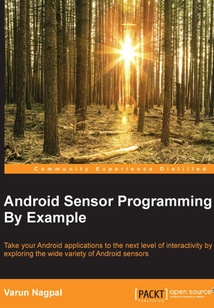首頁 > 計(jì)算機(jī)網(wǎng)絡(luò) >
編程語言與程序設(shè)計(jì)
> Android Sensor Programming By Example最新章節(jié)目錄
目錄(76章)
倒序
- coverpage
- Android Sensor Programming By Example
- Credits
- About the Author
- About the Reviewers
- www.PacktPub.com
- Why subscribe?
- Free access for Packt account holders
- Preface
- What this book covers
- What you need for this book
- Who this book is for
- Conventions
- Reader feedback
- Customer support
- Chapter 1. Sensor Fundamentals
- What are sensors?
- Motion position and environmental sensors
- Sensors' coordinate system
- Components of the sensor framework
- Sensor's sampling period power and battery consumption
- The reporting modes of sensors
- Dealing with specific sensor configuration
- Sensor availability based on the Android API level
- Best practice for accessing sensors
- Summary
- Chapter 2. Playing with Sensors
- Understanding the sensor framework callbacks
- Time for action - using sensors in the foreground activity
- Time for action – listing the available sensors on a device
- Time for action – knowing individual sensors' capabilities
- Time for action – getting the sensor values and updating the user interface
- Time for action – processing the sensor values in the background service
- What just happened?
- Summary
- Chapter 3. The Environmental Sensors – The Weather Utility App
- The weather utility app's requirements
- Understanding environmental sensors
- Time for action – using the temperature sensor
- Getting air pressure from the phone's pressure sensor
- Getting relative humidity from the phone's humidity sensor
- Summary
- Chapter 4. The Light and Proximity Sensors
- Understanding the light and proximity sensors
- The automatic torch light and screen brightness app requirements
- Time for action – turning the torch light on and off using the proximity sensor
- Time for action – adjusting the screen brightness using the light sensor
- Wake locks wakeup sensors and the FIFO queue
- Summary
- Chapter 5. The Motion Position and Fingerprint Sensors
- Understanding motion-based sensors
- Understanding position-based sensors
- The fingerprint sensor
- Time for action – shake detection using the accelerometer sensor
- Time for action – the compass using orientation sensor and orientation APIs
- Time for action – using the fingerprint sensor
- What just happened?
- Summary
- Chapter 6. The Step Counter and Detector Sensors – The Pedometer App
- The pedometer app's requirements
- Understanding the step counter and step detector sensors
- Time for action – using the step counter sensor in activity
- Time for action – maintaining step history with the step detector sensor
- Understanding the walking jogging and running signatures using the accelerometer sensor's data
- Time for action – type of step (walking jogging and running) detection using the accelerometer sensor
- Summary
- Chapter 7. The Google Fit Platform and APIs – The Fitness Tracker App
- The Google Fit platform
- Platform basics
- Authorization and permission scopes
- Fitness tracker app using fitness APIs
- Fitness tracker application requirements and architecture
- Time for action – working with live fitness data using the Sensors API
- Time for action – recording fitness data in background using Recording API
- Time for action – getting history fitness data using the History API
- Summary 更新時(shí)間:2021-07-16 11:08:21
推薦閱讀
- Facebook Application Development with Graph API Cookbook
- 工程軟件開發(fā)技術(shù)基礎(chǔ)
- GraphQL學(xué)習(xí)指南
- OpenCV for Secret Agents
- Access 2010數(shù)據(jù)庫基礎(chǔ)與應(yīng)用項(xiàng)目式教程(第3版)
- Kotlin Standard Library Cookbook
- Mastering Python Networking
- 手把手教你學(xué)C語言
- SQL基礎(chǔ)教程(視頻教學(xué)版)
- TypeScript項(xiàng)目開發(fā)實(shí)戰(zhàn)
- Building an RPG with Unity 2018
- Learning OpenCV 3 Computer Vision with Python(Second Edition)
- 微服務(wù)從小白到專家:Spring Cloud和Kubernetes實(shí)戰(zhàn)
- Mastering Web Application Development with AngularJS
- 微信小程序開發(fā)邊做邊學(xué)(微課視頻版)
- 創(chuàng)新工場講AI課:從知識到實(shí)踐
- 你必須知道的.NET(第2版)
- C#網(wǎng)絡(luò)編程高級篇之網(wǎng)頁游戲輔助程序設(shè)計(jì)
- Flask Web開發(fā)實(shí)戰(zhàn):入門、進(jìn)階與原理解析
- 機(jī)器學(xué)習(xí)開發(fā)者指南
- Learning IPython for Interactive Computing and Data Visualization(Second Edition)
- Balsamiq Wireframes Quickstart Guide
- Microsoft HoloLens Developer's Guide
- Cocos2D-x權(quán)威指南
- Java應(yīng)用架構(gòu)設(shè)計(jì):模塊化模式與OSGi
- Unity 2018 Cookbook(Third Edition)
- 小創(chuàng)客趣玩micro:bit開發(fā)板編程
- Learning Julia
- The Applied SQL Data Analytics Workshop
- 高可用可伸縮微服務(wù)架構(gòu):基于Dubbo、Spring Cloud和Service Mesh


